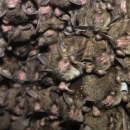UPDATED zip-drive folder containing a shapefile for the Indiana bat habitat suitability model and the Northern long-eared bat suitability model.
To further refine the model output, we created a grid of five-acre hexagons for Michigan using the “Generate Tessellation” tool in ArcPro 2.9. The five acre size was selected as the patch size based on available literature and data suggesting that Indiana and northern long-eared bats (Bats) are unlikely to occupy an isolated forest stand of less than five acres. The hexagon layer was then “Clipped” to the state of Michigan. The total acres of modeled Bats habitat were summarized by hexagon using the “Summarize Within” tool. Hexagons with less than one acre of either Bats habitat were then removed. These small model fragments were typically isolated from other modeled hexagons, likely artifacts of imprecise raster data, and were considered unlikely to provide sufficient habitat to support roosting Bats. Hexagons containing more than one acre of either modeled habitat were retained, helping to fill gaps and buffer edges among smaller but closely connected modeled patches and increasing the overall acreage of modeled habitat within the species’ range.
The remaining hexagons were then aggregated using the “Dissolve” tool allowing for multipart features. The “Summarize Within” tool was run again to obtain acres of modeled habitat within each hexagon cluster. We then ran a “Near Neighbor” analysis to identify forest patches that were greater than 1,000 feet from forested areas to remove isolated patches unlikely to be used by roosting Bats. We removed hexagons that were more than 1,000 feet from their nearest neighbor and that contained less than five acres of modeled habitat. These isolated forest patches are considered unlikely to support roosting Bats due to their insufficient size and distance from other suitable, modeled areas. The final layer was then checked against known roosting areas and detections. An additional three hexagons were added to the model to capture locations that fell outside of the modeled habitat.


